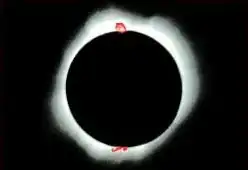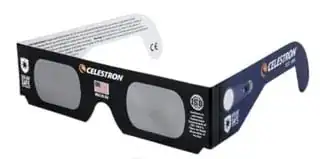Although rare, it is possible to see solar prominences with the naked eye during a total solar eclipse. The most recent was in 1991 when two very large prominences were visible to the naked eye during the total eclipse which was visible in Baja California and on the Island of Hawaii (aka the Big Island). Note that because of the distance and small apparent size, to the naked eye the prominences looked like small crimson colored smudges on the edge of the Sun, not like the "flames" that you see in astronomical photos. During most eclipses however the prominences are much smaller and would not be visible with the naked eye, although possibly with binoculars.
Below is the only copyright-free photo of the 1991 eclipse that I could find that shows the prominences. Some better views of the 1991 eclipse can be seen on the Mr. Eclipse website and on the MMV project website.

1991 Total Solar Eclipse (photo: Werner Raffetseder, via: Wikimedia Commons, CC BY-SA 3.0)
The prominences visible in a more typical total solar eclipse can be seen in a photo of the 2015 eclipse on the London Natural History Museum website.
Flare vs. Prominence
As mentioned in another answer, a solar flare will not be visible to the naked eye. In fact it would probably not be visible even with binoculars or telescopes unless using special filters. As described in Britannica:
The most spectacular phenomenon related to sunspot activity is the solar flare, which is an abrupt release of magnetic energy from the sunspot region. Despite the great energy involved, most flares are almost invisible in ordinary light because the energy release takes place in the transparent atmosphere, and only the photosphere, which relatively little energy reaches, can be seen in visible light. Flares are best seen in the Hα line, where the brightness may be 10 times that of the surrounding chromosphere, or 3 times that of the surrounding continuum.
Prominences on the other hand can be visible during a total eclipse:
As with the chromosphere, prominences are transparent in white light and, except during total eclipses, must be viewed in Hα. At eclipse the red Hα line lends a beautiful pink to the prominences visible at totality.
Binoculars
It is safe to look at a total eclipse with binoculars, just as it is safe to take pictures with a telephoto lens which many people do, but only DURING TOTALITY. As mentioned in some of the comments there is a risk if you are not very careful. First of all you must be in the path of totality. Being in an area that will experience 98% or even 99% totality is not the same thing. It's sort of like being somewhat pregnant, you are either in totality or you are not. Anyone who has been in the path of totality for a total solar eclipse knows what I am talking about. If someone lives in one of the areas that will experience near totality, they should make every effort to travel the 100-200 miles or whatever it takes to get into the path of totality, otherwise they will miss the experience of a lifetime.
Even for the last few seconds before totality the tiny piece of Sun that is still visible is very bright, and can be damaging to the naked eye. The problem is that the volume of light reaching your eye at that time is much lower than normal, and so you will not feel any pain and will likely not have the reflex to look away. Even though the sky and surrounding area is getting dark, as long as even a tiny sliver of sunlight appears you must continue to only look at the Sun through eclipse glasses.

Note that it's a good idea to purchase eclipse glasses a few months before a total eclipse as they will begin to sell out as it gets closer. Welders glass can also be used, but it must be at least shade 14 which is generally not available in a typical hardware store.
Once totality starts it is safe to look at the Sun with the naked eye, binoculars, telephoto lens, etc. In North America totality will last four and a half minutes, although that is only in the center of the track, it can be less if you are further from center. The important thing for safety is to only look with binoculars, etc. during the first part of totality, since your sense of time will be somewhat distorted. My personal experience is that time seems to come to a standstill. So plan to spend maybe 30 seconds or so looking with binoculars, which should be plenty of time to observe any detail. For added safety you can set a timer to go off about a minute before totality ends. But realistically you will probably quickly realize that the naked eye view is much more impressive. Just remember that once you put your binoculars and/or camera down, don't pick them up again for the duration of the eclipse.
Also remember that the moment at the end of totality when the first tiny piece of Sun appears you should immediately begin using your eclipse glasses, as again even that tiny piece of light can be very damaging to your eyes if you stare at it. Some people don't trust their self-discipline to look away when the Sun reappears, and so they put on their eclipse glasses during the last minute of totality. There is nothing wrong with that approach either as it would be the absolute safest.
My personal opinion, having seen a total eclipse, is to forgot binoculars, cameras, etc. and just take it all in. Or plan to use those items only for the first 30 seconds or so, and then put them down and enjoy the spectacle.

